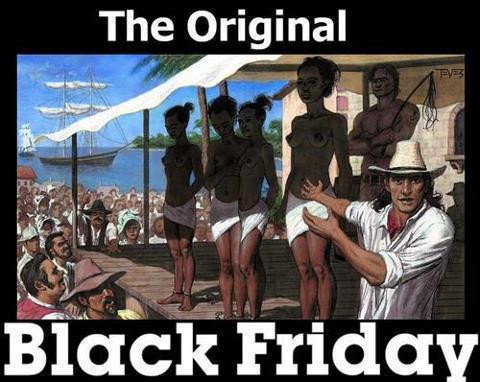BLACK FRIDAY – ЦРН ПЕТОК!!! Што е тоа, а? Идиотите што трчаат по продавници за на “попуст“ да купат нешто што е поскапо од цената во регуларните денови, знаат ли за кој РАСИЗАМ и НЕЧОВЕЛНОСТ СЕ РАБОТИ?!
Разбраа ли кретените кој го нападнаа Сити Мол?
Блек Фрајдеј значеше директна ликвидација на остатокот од непродадените црни робови, од нивните бели господари на пазарот на јавните плоштади. Пред да заминат за Африка да ловат нова, свежа робовска сила.
Така, робовите биле изложени на стотици купувачи, кои купувале и ги носеле на своите плантажи за да работат со памук, шеќерна трска или во своите домови за да ги извршат домашните задолженија.
Оваа верзија често не е цитирана, можеби поради причините на спокојството и да се избегне тоа што ја дели Америка, како и вистинската верзија на Денот на благодарноста што всушност е денот кога Индијанците (домородните) одлучија да им дадат ќебиња на белите доселеници, така што тие не умираат од студ, со што се означува примирјето во војната што им се спротивставува, симболизирано со споделување на храна меѓу двата кланови.
Еве текст и на англиски и на француски:
But there was a time when this celebration meant the outright liquidation of the rest of unsold black slaves, by their white masters on the market of the public square. Before leaving for Africa to catch new, fresh, and renew the stock.
Thus, slaves were exposed to hundreds of buyers, who made their choice and brought them back to their plantations to work with cotton, sugar cane, or in their homes to do the household chores.
This version is not often quoted, perhaps for reasons of tranquility and avoid that it divides America, as well as the true version of Thanksgiving which is in fact the day when Indians (indigenous) have decided to give blankets to the white settlers so that they do not die of cold, thus marking a truce in the war which opposed them, symbolized by a sharing of food between the two clans.
Mais il fut un temps où cette célébration désignait la liquidation pure et simple du reste d’esclaves noirs non vendus, par leurs maîtres blancs sur le marché de la place publique. Avant le départ vers l’Afrique pour en attraper de nouveaux plus frais, et renouveler ainsi le stock.
C’est ainsi que des esclaves étaient exposés devant des centaines d’acheteurs, qui faisaient leur choix et en ramenait dans leurs plantations pour travailler du coton, de la canne à sucre, ou dans leur maisons afin d’effectuer les taches domestiques.
Cette version n’est pas souvent citée, peut-être pour des raisons de tranquillité et éviter qu’elle ne divise l’Amérique, de même que la véritable version de la Thanksgiving qui est en fait le jour où les indiens (autochtones) ont décidés de donner des couvertures aux colons blancs pour pas qu’ils meurent de froid, marquant ainsi une trêve dans la guerre qui les opposait, symbolisée par un partage de nourriture entre les deux clans.

